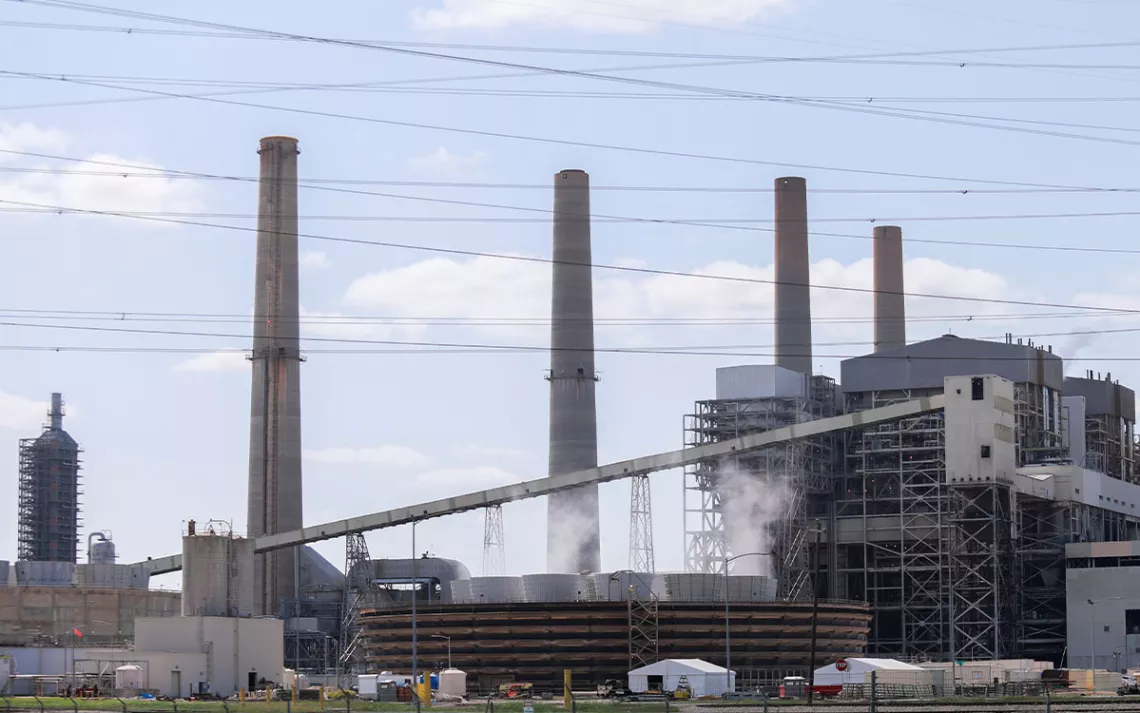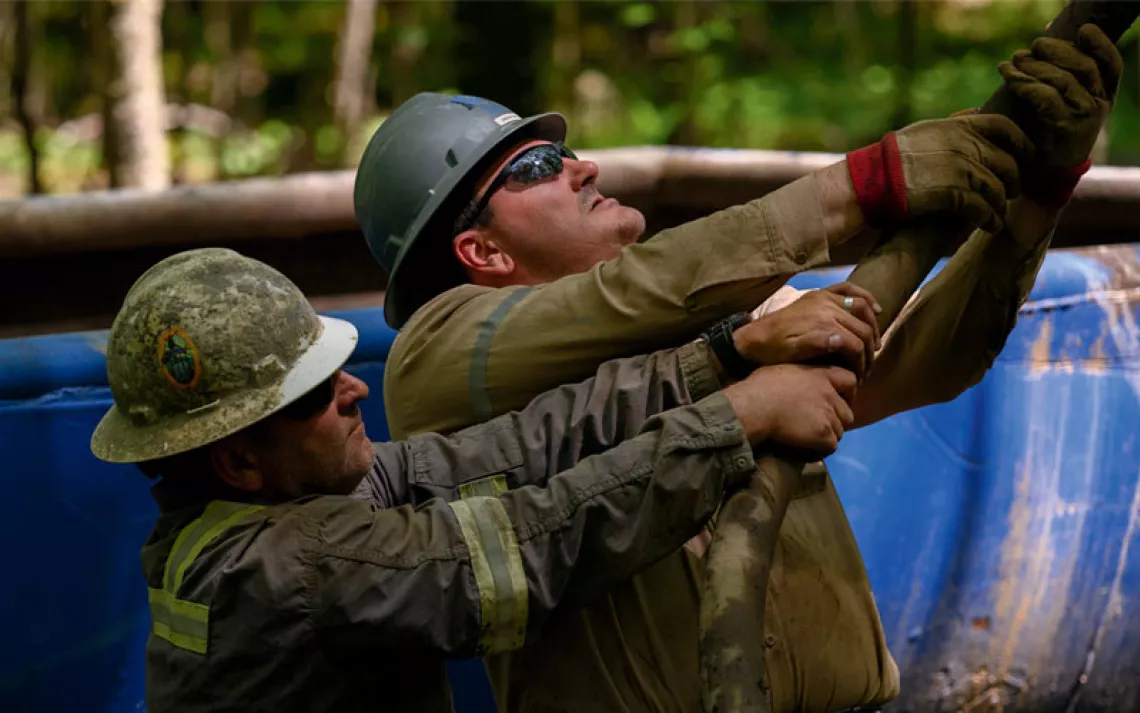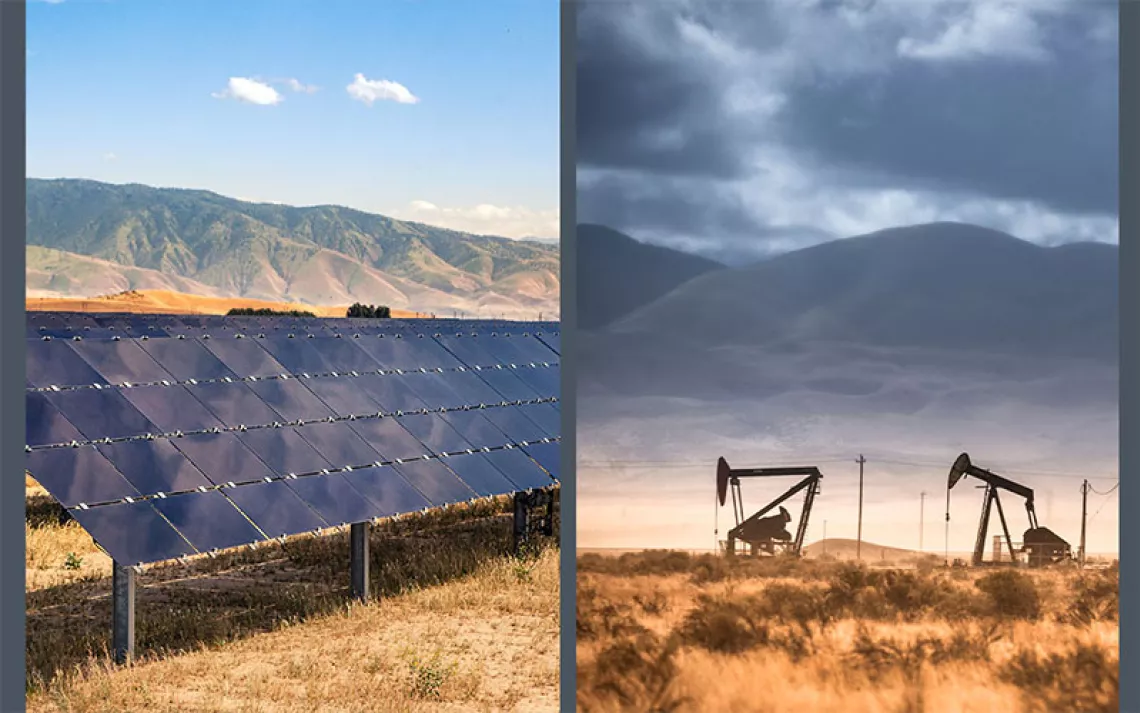Carbon Capture and Storage at Fossil Plants Is Promoted as a Needed Climate Solution
But some advocates say it allows big polluters to do business as usual while hurting local communities

W.A. Parish Generating Station in Fort Bend County near Houston, Texas. | Photo by Reginald Mathalone/NurPhoto via AP
Editor’s note: Amal Ahmed reported this story as a freelance journalist but has since taken a job with the National Wildlife Federation.
When Carmen Cavezza first moved to Houston five years ago, she settled in a neighborhood that was under the shadow of the W.A. Parish coal plant. Built in the 1970s, the power plant was notorious for the pollution it spewed onto nearby neighborhoods. Research has linked the plant’s pollution to more than 100 excess deaths every year, and environmentalists have been pushing for its closure for years.
In 2017, the facility became the first power plant in the United States to begin operating carbon capture and sequestration (or CCS) technology at one of its units, a project it calls Petra Nova. “There was a lot of noise about how it would bring a lot of jobs and stuff like that,” Cavezza, who worked in health care at the time, recalled. “For me, it was just like, ‘What is this?’ I did a quick search and nothing more.”
CCS is a technology that removes some portion of carbon dioxide from an industrial facility’s flue stream before it is released to the atmosphere, then transports it via pipelines either to be sequestered in an underground geologic formation or used for some other purpose. Most analysts believe that CCS will be an important technology to help advance the transition toward a net-zero economy by reducing emissions in hard-to-decarbonize sectors like steel manufacturing and cement production.
However, CCS projects at power plants and other fossil fuel facilities, such as liquefied natural gas (LNG) import-export terminals, have been dubiously hailed by some as something of a silver bullet for the climate crisis, even while cleaner and far cheaper options like wind and solar are readily available. CCS technology would (they argue) allow business as usual to continue at these facilities while reducing greenhouse gas emissions. Plant owners would profit off their existing infrastructure while reaping the benefits of expanded tax credits in the Inflation Reduction Act, the Biden administration’s signature spending bill.
Plants like the one in Houston can also be used for enhanced oil recovery—captured carbon is pumped back underground into oil wells to squeeze out the last few drops of hydrocarbons. When the price of oil went negative in 2020, Petra Nova was shut down for three years as it was no longer economical. It began operating again in September.
When CCS technology is maximally deployed, it can capture upward of 90 percent of carbon emissions produced by a facility. However, independent estimates based on the industry’s own data indicate that plant owners often opt for partial rather than full capture (although proposed EPA regulations for power plants would require at least 90 percent capture at certain power plants starting as early as 2030). Another concern is the fact that the geologic sites used for carbon sequestration can leak, resulting in more emissions of greenhouse gases. Complicating the technology even more, subpar or unenforced safety measures can cause carbon pipelines to explode, causing serious harm to communities nearby.
In Satartia, Mississippi, when a carbon pipeline exploded in 2020, dozens of people were hospitalized after they breathed in high concentrations of pure CO2. The gas is an asphyxiant, meaning that it displaces oxygen from the air and makes it hard for people to breathe. The World Health Organization has warned that there’s very little research about carbon exposure on public health; the Satartia disaster was the first time such an event had occurred. The federal Pipeline and Hazardous Materials Safety Administration has promised updated regulations for CO2 pipelines in the near future, but they have yet to propose any.
CCS projects at fossil fuel facilities in Houston and other areas of the Gulf Coast in Texas would bring that infrastructure much closer to population centers than ever before. But when companies are trying to sell these projects to community members, industry representatives rarely speak publicly about these risks, advocates say. That work often falls to grassroots groups and people like Cavezza. These days, she works as a climate justice organizer with the Coalition for Environment, Equity & Resilience (CEER). She knows better than most how coal plants like W.A. Parish threaten public health and exacerbate the climate crisis that has led to more devastating storms like Harvey.
It’s been hard to rally public outrage around the wave of CCS projects at fossil plants that may be coming to Houston in the near future, even as some of the region’s biggest companies have announced their intentions.
“Environmental justice communities are dealing with so much that there’s certain things that fly under the radar,” Cavezza said. CEER focuses on issues like disaster recovery and fair housing. It’s hard for staff members to be caught up on every new development, as well, she added. “Community members find out about these projects when it’s too late. The permits are underway, and there’s no transparency about how they’re going to be affected.”
This summer, a Houston-based environmental advocacy group called Air Alliance worked with groups like CEER to complete a six-month community survey on local attitudes toward CCS. The survey found that the biggest challenge is simply a lack of information about what the projects are and what they’ll mean for residents who live closest to the new technology.
Stakeholders—from residents to city staff—expressed that they were concerned about climate change, but many said they weren’t familiar enough with CCS to rate its effectiveness as a climate solution. In community meetings, the group found that they often had to first educate residents about carbon capture and storage before administering the survey. “More than likely, our presentation on the topic was the first time that respondents received fact-based exposure to the concepts and terms surrounding carbon capture technology,” the organization reported.
“The most advanced community outreach work requires continual involvement in a community—not just at the beginning of a project or when it’s closing out,” said Alexander Spike, a climate justice advocate at Air Alliance. That type of engagement has been lacking around the CCS proposals in the Houston area, he said. And there’s already often a lack of trust in public meetings in some environmental justice communities, given that so many projects appear to be rubber-stamped.
“There’s a really deep urgency in making sure that communities have the knowledge to advocate on their own behalf,” Spike said, particularly as the Inflation Reduction Act opens up billions of dollars of funding to move these projects off the ground fast. “Industry is able to use the lack of knowledge in the community to get projects through the required engagement before we can demand mitigation or demand safety improvements and get a whole lot more out of a community benefits agreement than we typically would.”
But while community members were often hearing about CCS for the first time at presentations hosted by nonprofit civic groups, Air Alliance found that city staff had already been briefed on the technology by industry trade groups, like the Houston CCS Alliance. The coalition includes some of Houston's largest fossil fuel companies, such as Dow, ExxonMobil, Shell, Chevron, and Phillips 66, and it has pushed CCS—including at fossil-fuel-burning power plants—as a solution to the climate crisis.
“They are able to be that lone voice in the room and get their voice out there first,” Spike said. City staff was still willing to listen to presentations from groups like Air Alliance as well, he added. The CCS Alliance did not respond to requests for comment.
The same story is playing out in other communities where the newly emerging industry has set its sights. In Brownsville, two LNG plants have been approved for construction in the South Texas port city. “We don’t want industrial buildout in our community,” Bekah Hinojosa, a long-time environmentalist from the area, said. For years, community members have been rallying around the projects, pressuring local, state, and federal governments to reconsider their support.
For some time, the projects struggled to secure long-term export deals with European countries since the gas terminals would mostly process methane-intensive fracked gas from Texas’s Permian Basin. Adding a CCS unit seemed to have sweetened the deal and allowed at least one company, Rio Grande LNG, to label itself as the “greenest LNG project in the world” and sign contracts with the French government.
“This technology is propping up Rio Grande LNG’s greenwashing,” Hinojosa said. “And our community has been left in the dark—Rio Grande hasn’t shared any plans about what the CCS project would look like.”
The Federal Energy Regulatory Commission has held public meetings on the carbon capture unit at Rio Grande LNG, but Hinojosa said that it’s frustrating that the agency doesn’t provide the community with information about the project. So organizers took it upon themselves to create flyers in English and Spanish explaining the public health and climate risks of CCS projects. “They claim it’s going to reduce emissions,” Hinojosa said, “but Rio Grande LNG will still be the biggest polluter of cancer-causing emissions with or without the carbon capture.”
Meanwhile, in Corpus Christi, Elida Castillo can recite a laundry list of heavy industrial projects that worry her and other community members: A stone’s throw away from residential neighborhoods, there’s the liquefied natural gas plant and the oil export terminal; a desalination plant that’s been in talks for years; and more recently, a lithium battery factory coming to town. But compared with advocacy on other initiatives and polluting facilities, Castillo said, it feels like she’s starting from scratch on educating residents about CCS.
“We had an invite from the Port of Corpus Christi a couple of years ago about carbon capture, and they just couldn’t answer our questions,” she recalled. “There was a promise for more, but as far as I know, we didn’t have any follow-up conversations on CCS and the concerns we brought up.” Now, the port has already signed a deal, with the support of the Department of Energy, to study the potential for offshore carbon sequestration. The State of Texas also recently awarded another offshore lease to a Spanish energy company, Repsol, to develop a project on state-owned offshore lands.
By and large, it’s clear that CCS projects at power plants and LNG facilities will likely help keep fossil fuel companies in business, and Castillo sees the projects, and the federal support for them, as a major contradiction.
“The fact is that this doesn’t address the climate crisis we’re in,” she said. “At the end of the day, the port and the companies are making money, but we are bearing the brunt of the harm.”
 The Magazine of The Sierra Club
The Magazine of The Sierra Club



